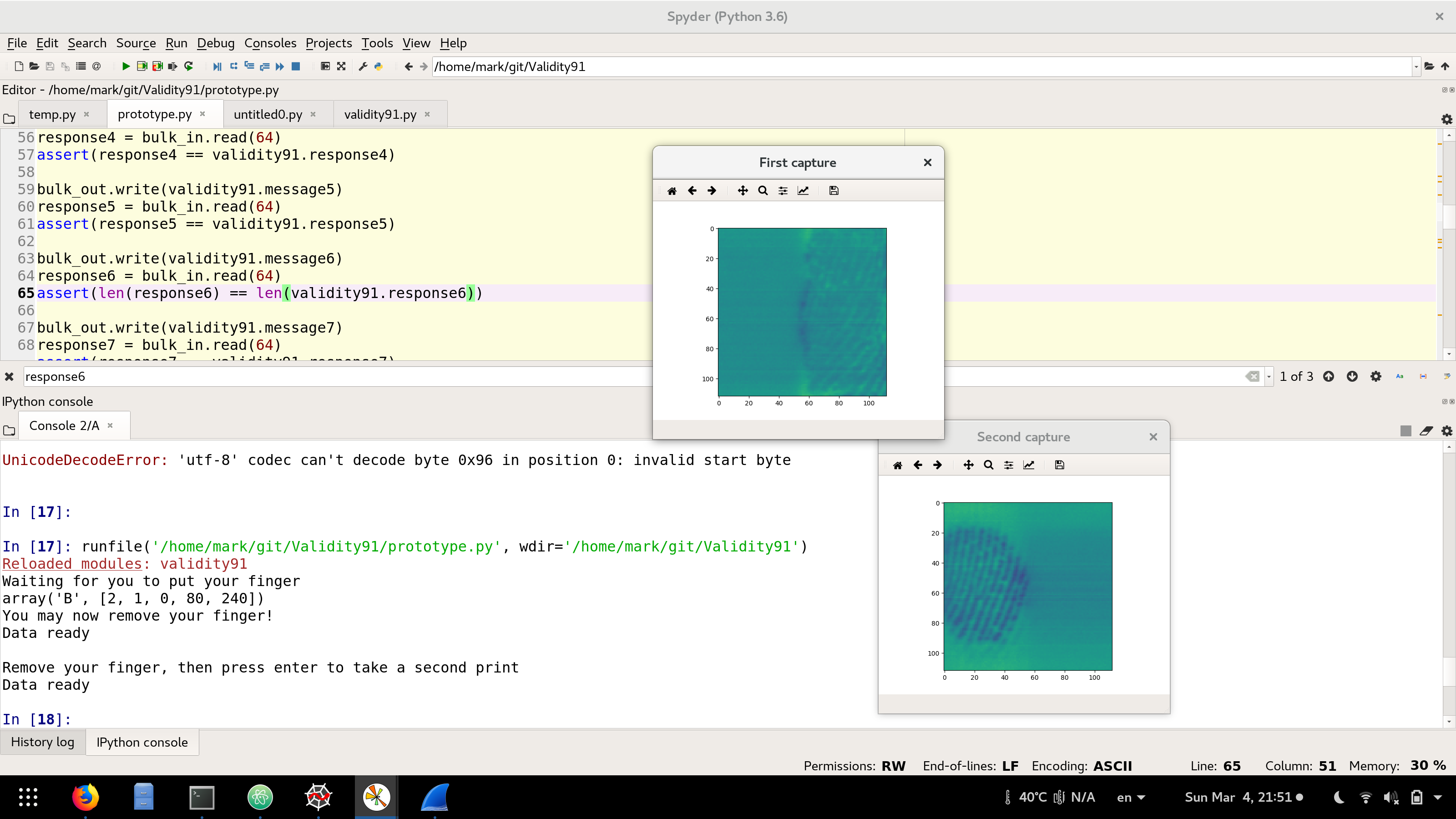Validity 91
This project aims at reverse engineering the protocol of the Validity 138a:0091 fingerprint sensor that is found on the XPS 15 9560, XPS 13 9360 and potentially other laptops. Apart from a few edge cases, this part is done. Yay!
Unfortunately, the matching algorithm used in the previous libfprint driver doesn't work with this sensor. They seem to rely on a single high quality image to do the matching, something that is never obtained. See this issue for more details.
This sensor should be pretty straightforward to reverse engineer since apparently it doesn't encrypt the traffic between the sensor and the OS. A big thanks to Nikita Mikhailov, from whom I learned that it is likely just unencrypted traffic. They are working on a similar project for a sensor that has encryption capabilities
Wireshark was used to sniff through traffic sent to and from the USB.
Roadmap
| Task | Status |
|---|---|
| Create a script that dumps the output from others' laptops | Done |
| Find the size of the image | 112✕112 image |
| Find the initialization commands | WOMM |
| Find the commands required for putting the sensor to sleep | WOMM |
| Learn how to integrate with libfprint | Getting there |
| Detect when finger is on the sensor | WOMM |
| Detect when finger is taken off (is it possible?) | WOOM |
| Develop a new fingerprint matching algorithm | 112x112 is too small for the previous one |
Getting started
Running prototype
You can use conda (not until 3.7 comes out because i decided to use dataclasses)
if you like, but I provided a Pipfile that should make it easy to use pipenv.
Installing pipenv
pkcon install pipsipipsi install pipenv
Run the script
Change to the project directory, and run
pipenv installsudo make permissionspipenv run python3 prototype.py
Or you may choose to run it within spyder
3. pipenv run spyder3
4. Open the prototype.py file
5. Run it within Spyder
Wireshark development
The main strategy is to use Wireshark and a Windows Guest OS running in VirtualBox to capture all the traffic between a working Windows implementation and the sensor. I don't really think this is SUPER necessary. I was able to obtain a dump of the enrollment process on windows.
- Install libusb:
pkcon install libusb-devel - Install Wireshark:
pkcon install wireshark1. Set it up to capture USB output 2. Uselsusbto find what USB bus the fingerprint sensor is connected to:Bus 001 Device 003: ID 138a:0091 Validity Sensors, Inc.
- Install VirtualBox:
pkcon install VirtualBox - Install VirtualBox Extension Pack
- Allow VirtualBox to run off your existing Windows partition * Warning, I kinda got activation warnings from Microsoft. I think they might be related to doing this. It might be more prudent to have a separate virtual drive running an unactivated version of Windows 10 but I just don't have the hard drive space for it.
- Run Windows10, and capture the fingerprint output.
Add your user to the vboxusers group so you can share the USB devices:
sudo usermod -a -G vboxusers $USERyou might need
sudo make wireshark
to set the correct wireshark permissions for USB sniffing. You might want to use a wireshark filter like:
usb.addr == "1.6.0" || usb.addr == "1.6.1" || usb.addr == "1.6.2" || usb.addr == "1.6.3" || usb.addr == "1.6.4"
Helping out
This code doesn't send anything to the cloud. But, if you want to help develop this, considering sharing the difference in your dump file, dump.txt.
I don't think it contains any personal information. As far as I know, I don't dump the fingerprint data.
I think the easiest way is to post a diff on Pastebin:
git diff dump.txtand copy the output.
Let me know if you got a semblance of a fingerprint from the script.
Reverse engineering
So I am working off a single dump using my VirtualBox and Windows10 trying to log on to my computer. I'll try to share a new dump file from the enrollment procedure.
That should teach us how to detect when a finger is taken off too. But honestly, I don't know how to do this without making my fingerprints public on the web...
Here is a sample from the script from the side of my fingers:

Chat
Similar projects
- Validity90 works on doing this for sensors with encrypted traffic.
- libfprint-vsf0090 Apparently made a PPA for fprint with the validity 0090 sensor
- libfprint did this a while back for many sensors. Apparently we need to work toward this
